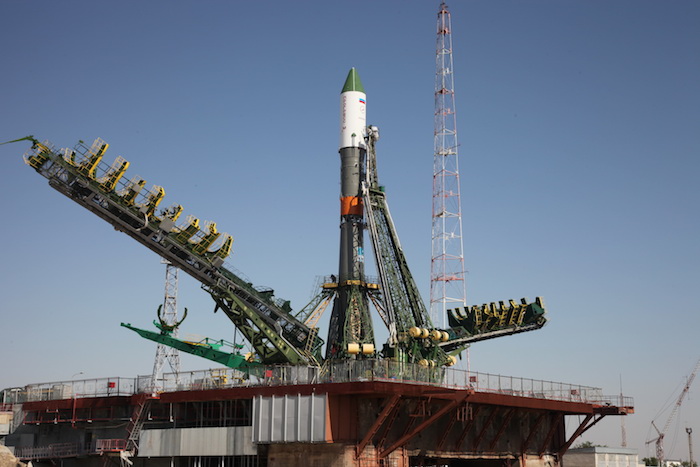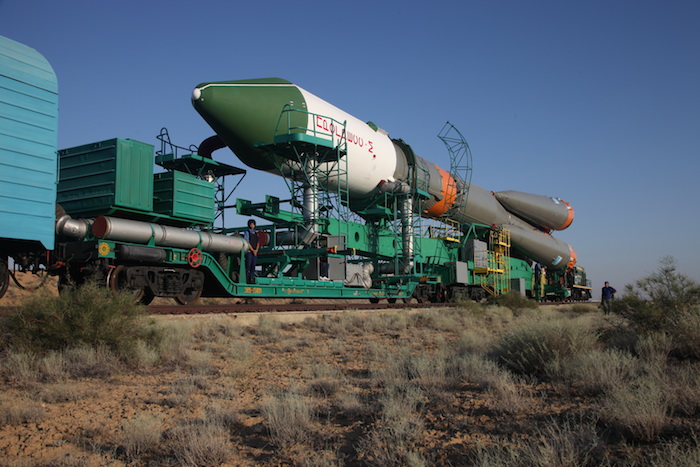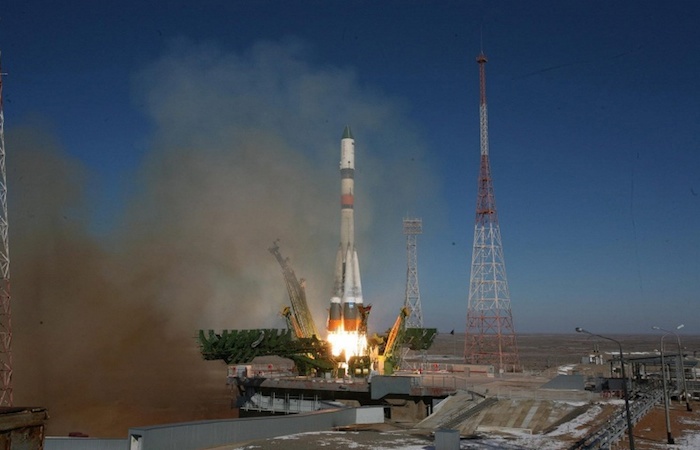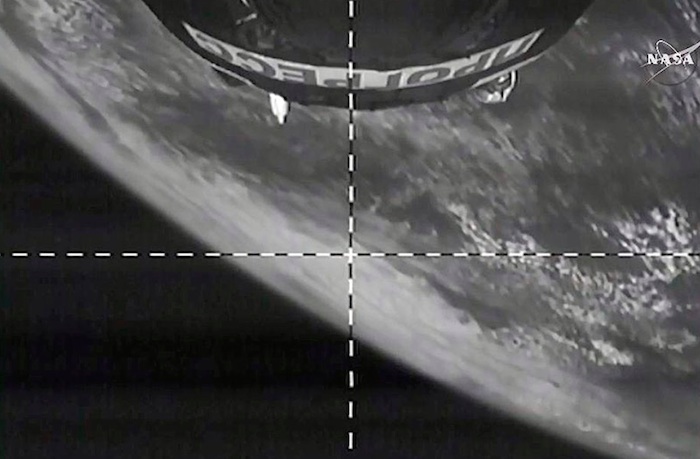.
1.07.2015
NASA TV Coverage Set for Space Station Cargo Ship Launch and Docking
NASA Television will provide live coverage of the launch and docking of an unpiloted Russian resupply ship to the International Space Station (ISS).
The ISS Progress 60 spacecraft will launch from the Baikonur Cosmodrome in Kazakhstan at 12:55 a.m. EDT (10:55 a.m. Baikonur time) on Friday, July 3, on a two-day trip to deliver more than three tons of food, fuel and supplies to the Expedition 44 crew. NASA TV coverage of the launch will begin at 12:30 a.m.
Progress is scheduled to dock to the station at 3:13 a.m. Sunday, July 5. Docking coverage will begin at 2:30 a.m.
The Progress is loaded with 1,940 pounds of propellant, 106 pounds of oxygen, 926 pounds of water and 3,133 pounds of food, spare parts, logistical items and experiment hardware. The station currently is in good shape with adequate supply levels until at least October.
This is the first Progress launch since the loss of the ISS Progress 59 cargo spacecraft following its liftoff from Baikonur on April 28.
Quelle: NASA
-
Update: 2.07.2015
.
Soyuz rocket rolled out for critical ISS cargo launch

A Russian Progress supply ship is shrouded inside the nose of a Soyuz rocket for launch Friday on a critical cargo delivery mission to the International Space Station. Credit: Roscosmos
.
An eight-ton Russian Progress supply ship packed with nearly three tons of food, water and fuel for the International Space Station is ready for liftoff Friday on a vital mission to resume cargo missions to the outpost after back-to-back logistics flights fell short.
The Progress M-28M cargo freighter is crammed with propellant to refuel the space station’s propulsion system, fresh potable water, food, electronics, medical supplies and spare parts to restock the lab, which last received a supply shipment in mid-April.
Since then, two cargo missions launched toward the space station have failed.
First, a Progress freighter launched April 28 started tumbling minutes after launch, a problem blamed on vibrations in the connection between the spacecraft and the third stage of its Soyuz rocket, which flew in the upgraded Soyuz-2.1a configuration for the failed mission.
Russia switched to the older Soyuz-U rocket for Friday’s launch, which it says is not susceptible to the anomaly that struck the last Progress mission.
The second space station supply launch in a row failed June 28, when a SpaceX Falcon 9 rocket broke apart nearly two-and-a-half minutes after blastoff from Cape Canaveral with a commercial Dragon cargo craft, destroying more than two tons of gear inside, including a new docking adapter, a spacesuit and crew provisions.
Space station managers say the outpost and its three-person crew have sufficient reserves to continue flying until late October, and with at least two resupply missions — Friday’s Progress launch and an August flight of Japan’s HTV cargo craft — set to lift off before then, officials are, for now, keeping space station operations on schedule.
Three new crew members are supposed to launch July 22, increasing the size of the station’s crew to six. NASA and Russian authorities said the crew launch will go forward, pending a final series of standard readiness reviews.
.

Russian ground crews transferred the Soyuz rocket with the Progress M-28M supply ship to its launch pad Wednesday. Credit: Roscosmos
Meanwhile, Russian technicians are preparing for Friday’s launch to get the space station supply chain back on track.
The Progress M-28M spacecraft, bolted to the top end of the Soyuz-U rocket, rolled out to its launch Wednesday at the Baikonur Cosmodrome in Kazakhstan. The rocket arrived at Baikonur’s Launch Pad No. 1, the same facility where Yuri Gagarain launched to become the first person in space, after a railroad voyage from an integration hangar a few miles away.
The three-stage rocket was hoisted vertical by a hydraulic lift system, then rotating platforms moved around the launcher to give workers access to the vehicle final flight preparations.
Liftoff is set for 0455:50 GMT (12:55:50 a.m. EDT; 10:55:50 a.m. Baikonur time) from the historic launch base, and the Soyuz third stage is set to deploy the Progress M-28M spacecraft into orbit less than 10 minutes later.
The launch marks the 60th flight of a Russian Progress supply ship to the International Space Station since 2000. The flight is designated Progress 60P in the station’s manifest of assembly and resupply missions.
Once in space, the Progress capsule will deploy its power-generating solar panel wings and navigation antennas, then begin thrusting on a two-day rendezvous with the space station. Arrival at the lab’s Pirs docking compartment is scheduled for 0713 GMT (3:13 a.m. EDT) Sunday.
The spaceship is packed with 5,249 pounds (2,381 kilograms) of cargo, according to a manifest posted on the Russian space agency’s website, which provided a breakdown of the supply load:
1,146 pounds (520 kilograms) of propellant to refuel the space station’s Zvezda service module
926 pounds (420 kilograms) of water
105 pounds (48 kilograms) of air and oxygen
3,071 pounds (1,393 kilograms) of dry cargo, including:
Food, napkins and food waste containers
Toilet devices, liners and waste containers
Medical supplies, personal hygiene items, and health and air monitors
Batteries, computers, chargers, tools and fire extinguishers
Science experiment hardware
American and European equipment
Quelle: SN
-
Update: 3.07.2015
.
Russian Supply Ship Launched to International Space Station
A Russian booster rocket on Friday successfully launched an unmanned cargo ship to the International Space Station, whose crew is anxiously awaiting it after the successive failures of two previous supply missions.
A Soyuz-U rocket blasted off flawlessly from Russia-leased Baikonur launch pad in Kazakhstan, placing the Progress M-28M ship into a designated orbit, safely en route to the station. On Sunday, it's set to dock at the station currently manned by Russians Gennady Padalka and Mikhail Kornienko and NASA's Scott Kelly.
The ship is carrying 2.4 metric tons of fuel, oxygen, water, food and other supplies for the crew, the Russian space agency Roscosmos said.
The previous Progress launch in April ended in failure, and on Sunday a U.S. supply mission failed too when SpaceX's Falcon 9 rocket broke apart shortly after liftoff. The mishaps were preceded by last October's launch pad failure of Orbital Sciences' Antares rocket, also carrying station cargo for NASA.
Despite the failures, NASA said the station is well-stocked, with enough supplies for the crew to last at least until October.
However, the trouble-free launch Friday was essential for the station program, which has exclusively relied on Russian spacecraft for ferrying crews after the grounding of the U.S. shuttle fleet.
SpaceX still hopes to meet the target of launching astronauts from U.S. soil again aboard the Falcon-Dragon combination in December 2017, which would allow NASA to stop buying seats from Russia to get astronauts to the space lab.
The Soyuz rocket is used to propel both Soyuz manned spacecraft and Progress cargo ships to orbit, so the launch of the station's next crew of three has been pushed back from late May to late July as space officials have looked into the reason for the rocket failure in April.
Russian space officials eventually have traced the failure to a leak from fuel and oxidizer tanks in the booster's third stage, which they said was caused by a yet unspecified flaw in the interface between the cargo ship and the latest Soyuz modification, called Soyuz 2.
The Soyuz-U rocket used Friday is an older sub-type of the rocket, which has been the workhorse of Soviet and Russian space programs for nearly half-a-century. Last month, the Interfax news agency reported that the Russian space agency will only be using that Soyuz modification until experts fully understand the reason behind April's failure and fix the flaw.
The station program has been one of a few sectors where ties haven't been hurt by a bruising Russia-West showdown over the crisis in Ukraine.
Quelle: abc-news
---
Russia’s Progress cargo spacecraft successfully enters orbit
This was the first launch of a cargo spacecraft to the International Space Station after two crashes, namely the loss of the Progress M-27M in April and the loss of US Dragon spacecraft in June

Russia’s Progress-M28M supply freighter has successfully entered the orbit and separated from the Soyuz-U carrier rocket, the Mission Control Center has told TASS.
"The cargo spacecraft has separated from the third stage of the carrier rocket," a representative of the Center said.
This was the first launch of a cargo spacecraft to the International Space Station after two crashes, namely the loss of the Progress M-27M in April and the loss of US Dragon spacecraft in June.
The freighter is due to dock with the ISS at 10.13 a.m. Moscow time (0713GMT) on July 5 in an automatic mode.
The process of berthing to the Pirs docking compartment of the Russian segment of the space station will be controlled by Russian cosmonauts Gennady Padalka and Mikhail Korniyenko.
In case the Kurs docking navigation system fails, the docking will be carried out by one of the cosmonauts in a manual mode.
Quelle: TASS
--
Progress M-28M launch resumes Russian cargo runs to space station

Russia's Progress M-28M cargo spacecraft seen in orbit above the Earth after launching from Kazakhstan on July 3. (NASA TV)
July 3, 2015 — Russia's 60th resupply ship launch to the International Space Station reached its intended orbit early Friday (July 3), marking a return to normal flight operations for the Progress spacecraft since a prior freighter tumbled out of control and was lost in late April.
Progress M-28M lifted off from the Baikonur Cosmodrome Pad No. 1 in Kazakhstan at 12:55 a.m. EDT (0455 GMT; 10:55 a.m. local) for a two-day rendezvous with the space station. The uncrewed craft is scheduled to linkup with the complex's Russian Pirs docking compartment at 3:13 a.m. EDT (0713 GMT) on Sunday (July 5).
The Progress is packed with more than 3 tons of supplies, including 3,071 pounds (1,393 kilograms) of crew logistics and science research; 926 lbs (420 kg) of water and 1,146 lbs (520 kg) of fuel for station's Zvezda module thrusters.
The success of this supply run is particularly important to the station's Expedition 44 crew given the recent losses of three different types of cargo ships. After a launch failure claimed an Orbital Sciences' Cygnus freighter in October, Russia's Progress M-27M was lost in April, and just earlier this week, a SpaceX Dragon cargo launch broke apart 139 seconds into flight.
By coincidence, all three of the launch failures took place on the 28th of their months (Cygnus on Oct. 28, Progress on April 28 and SpaceX on June 28).
Russia's investigation into the loss of the Progress M-27M pointed to a problem with its Soyuz 2.1a rocket's upper or third stage. For Friday's launch, the Progress M-28M lifted off atop a Soyuz-U, an older configuration of the booster.
"We understand the differences from the recent Progress failure," said William Gerstenmaier, NASA's chief of space operations. "They've essentially replaced the third stage of the rocket with an older configuration that has flown with Progress before."
With the failure of the previous Progress and the two U.S. commercial cargo ships, the station had enough supplies aboard to support its crew through October. Assuming the Progress M-28M docks as expected Sunday, it will extend the outpost's consumables by a month to November.
"We will have a lot of crew logistics — food and water and provisions," said Mike Suffredini, NASA's station program manager. "They're trying to get their supplies back up to a higher level, and so that, in turn, will drive the logistics up for the entire [space station]."
Currently, there are three crew members aboard the space station: NASA's Scott Kelly and Roscosmos cosmonauts Mikhail Kornienko and Gennady Padalka. They were to be joined by three more in May, but that launch was delayed in the wake of Progress M-27M.
Friday's successful launch clears the way for Soyuz TMA-17M to lift off July 22 with NASA astronaut Kjell Lindgren, cosmonaut Oleg Kononenko and Kimiya Yui of JAXA (the Japan Aerospace Exploration Agency).
"We are looking forward to getting those new guys up here pretty soon," Kelly said from orbit on Thursday. "We need their help up here ... it would be great to have some extra hands."
Progress M-28M, after docking Sunday, will be unpacked by the crew and repacked with spent equipment and trash. It is scheduled to depart the space station on Nov. 19 and be purposely destroyed during its re-entry into the Earth's atmosphere.
M-28M will be followed by JAXA's HTV freighter in August and then Progress M-29M, slated to launch in September.
Quelle:CS
3893 Views
